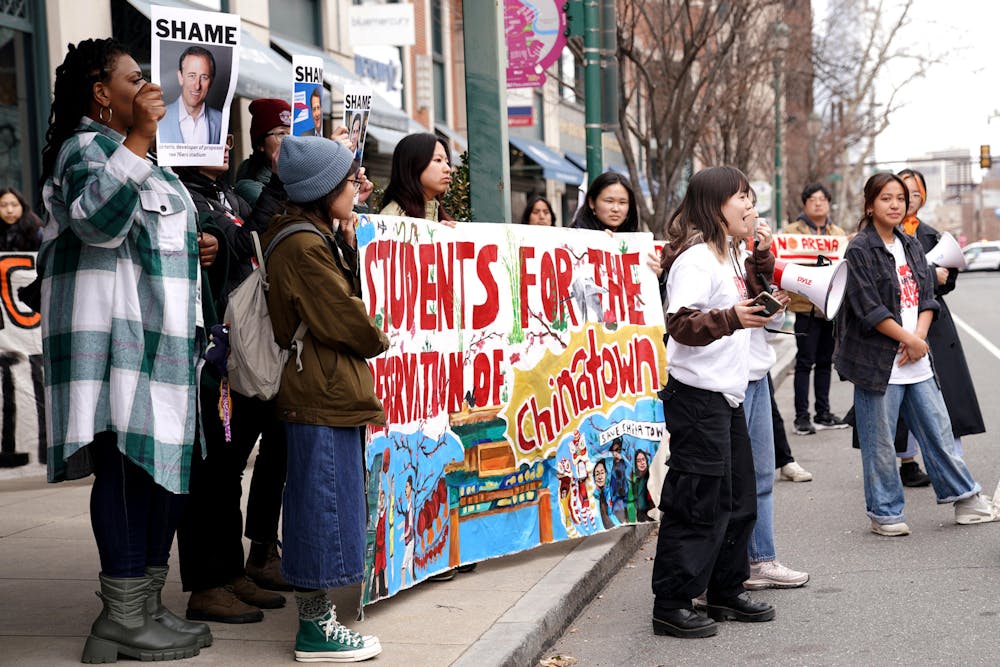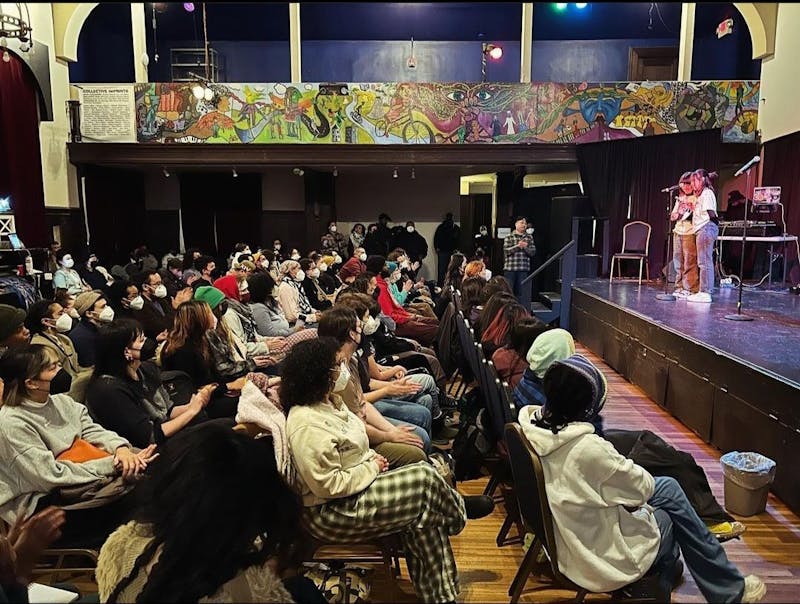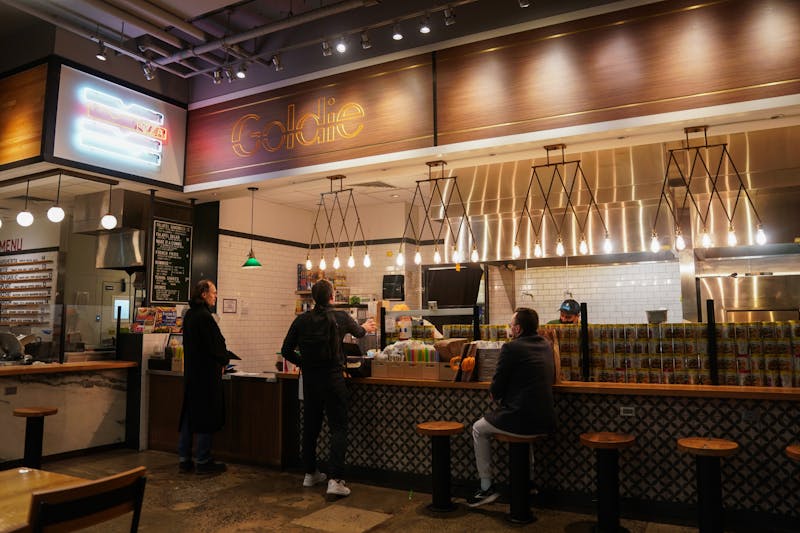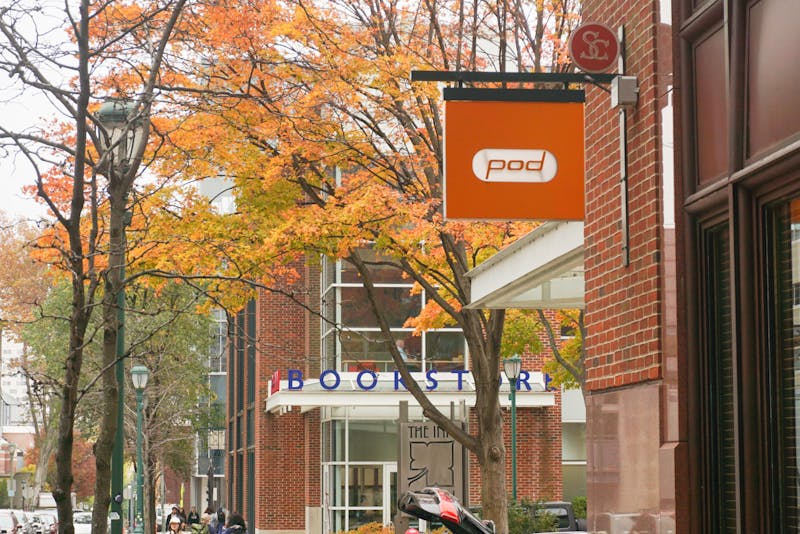
Students for the Preservation of Chinatown protested outside the Board of Trustees meeting held at the Inn at Penn on Mar. 3, 2023.
A few weeks ago, the streets of Chinatown came to life with firecrackers and lion dances ringing in the year of the dragon. As you walk through the brightly colored 40-foot paifang — known to most as Chinatown’s Friendship Gate — you enter into a cultural oasis that has stood strong in the heart of Philadelphia for nearly 150 years. Beyond this fixture, Chinatown serves as a home to nearly 3,000 residents and numerous family-owned businesses, restaurants, shops, and community organizations. Whether you are going to Ken’s Seafood Restaurant for a fun night out or Heng Fa for groceries, Chinatown feels like home.
Unfortunately, this community has been under constant attack for decades and is once again facing the threat of displacement and gentrification from a plan to develop an arena for the Philadelphia 76ers merely a block away. We firmly stand with the Students for the Preservation of Chinatown and urge you to do the same.
Since the early 1900s, Chinatown has been a victim of gentrification often driven by predatory infrastructure projects. In 1932, the construction of subway infrastructure at Ridge and Eighth streets — and the subsequent development of the Vine Street Expressway from 1957 to 1991 — resulted in the destruction of buildings and severe divisions within the community. Bringing in noise and pollution, the expressway eroded neighborhoods and people's quality of life. This was not Chinatown's sole battle, however, as it also faced multiple proposals of developments for a federal prison in 1992, a baseball stadium in 2000, and a casino in 2008.
The story of Philadelphia's Chinatown mirrors other Chinatowns across the nation. Amid the 1994 fiscal crisis in Washington, D.C., then-Washington Wizards owner Abe Pollin negotiated a deal for the downtown Capital One Arena, where the city covered pre-development costs to acquire and demolish properties. Entrepreneurs in Washington's Chinatown voiced concerns about prices of real estate skyrocketing and parking impacts on businesses in the area. A decade later, most Chinese residents were forced to move out due to unaffordable housing. The parking shortage led to the closure of the last Chinese grocery store, accelerating the decline of the Chinese American population in the area to fewer than 400 residents today. Ironically, as D.C.’s arena now relocates to the suburbs, the community is left behind, having endured irreversible destruction while in the midst of its recovery from the pandemic.
In New York’s Chinatown, threats of displacement and economic insecurity also loom high. In 2021, the Museum of Chinese in America accepted a donation of $35 million in support of a borough-based jail complex which would displace Chinese American working-class people in the area. On top of that, its board executives were connected to the closing of the last unionized restaurant, beloved Jing Fong banquet hall, and construction of luxury towers that are actively raising rent and real estate taxes in the area.
In Philadelphia, the current 76Place project is being developed by 76 DevCo, an initiative by 76ers managing partners Josh Harris, David Blitzer, and David Adelman. Adelman is at the forefront of the construction of the arena and has promised not to displace the residents or businesses in Chinatown, but his past actions speak louder than his current words. Adelman works closely with Brett Altman, who also owns the University City Townhomes, and was a key figure behind the demolition and end of affordable housing in the West Philadelphia area that was previously known as the "Black Bottom.” This constant cycle of displacing residents and communities that have lived in the area for generations must end, and we must be the voice to make this happen.
Developers of the project have stated that the arena will “serve as a model for an equitable & inclusive community,” yet there is not a single mention of Chinatown in the proposal. Efforts to ensure communities can benefit from this project read as empty promises when nearly 95% of residents, business owners, and visitors oppose the arena’s construction.
Many questions posed by residents have also gone unanswered by 76 DevCo. How will restaurants and small businesses in the surrounding area be protected? Who will clean the streets after huge events?
Preserving Philadelphia's architectural heritage demands careful consideration in urban development, but the development of the arena does the exact opposite — jeopardizing accessible low-income and senior housing complexes, healthcare clinics, and schools for children.
Penn has direct ties to the developers in the area, and students should be cognizant of the situation. Adelman currently sits on Penn Medicine Board of Trustees and is the CEO of Campus Apartments, which houses many Penn students off-campus. But more importantly, Penn students are directly and indirectly involved in the Chinatown community, whether that be Penn Lions performing all throughout the city for Lunar New Year, or student groups like SPOC organizing initiatives to honor traditions celebrating the multi-ethnic communities that reside there.
Despite what greedy developers may suggest, Chinatown is not an ethnic theme park but a home. It’s more than just a place to eat, it’s a support network and a cultural hub for immigrants and visitors alike.
In the face of ongoing threats, Chinatown has demonstrated remarkable resilience and activism, advocating for the needs of all diverse communities of color that are integrated into the cultural fabric of our city. The next time you are in Chinatown, take a look around at all the place has to offer. Venture into Ebisu for some home decor and enjoy a Mochinut donut as you shop. Come by Dae Bak for soul-nourishing Korean barbecue. The opportunities to support your favorite restaurants and local businesses are endless.
Please don't turn a blind eye to what is happening outside the Penn bubble. Pay attention to what SPOC and other organizers are doing in the fight for the preservation of Chinatown. Educate yourself on what is going on in Chinatowns across the country. If you can, participate in programming like Crane Chinatown Community Center art exhibitions or Show Your Love for Chinatown events to learn more about the challenges facing the neighborhood. Sign petitions.
Adorned with dragon motifs, and gorgeous ornamental roof tiles, the Friendship Archway is not only an architectural masterpiece, but a labor of love — created for community by community. The engineers and artisans from Tianjin, China — Philadelphia’s sister city — came together with residents and the city of Philadelphia to fund and invest in Chinatown, and you should too.
The next time you walk through the gate, remember that the fight for Philadelphia’s Chinatown, and Chinatowns everywhere, is not over. Speak up and fight for the movement so that history does not repeat itself.
More resources:
GoFundMe for Ginger Arts Center
LIALA SOFI is a College junior from Roanoke, Va. Her email address is lsofi@sas.upenn.edu.
CATHY LI is a College junior studying English and design from Brooklyn, N.Y. Her email address is licathy@sas.upenn.edu.
The Daily Pennsylvanian is an independent, student-run newspaper. Please consider making a donation to support the coverage that shapes the University. Your generosity ensures a future of strong journalism at Penn.
Donate











